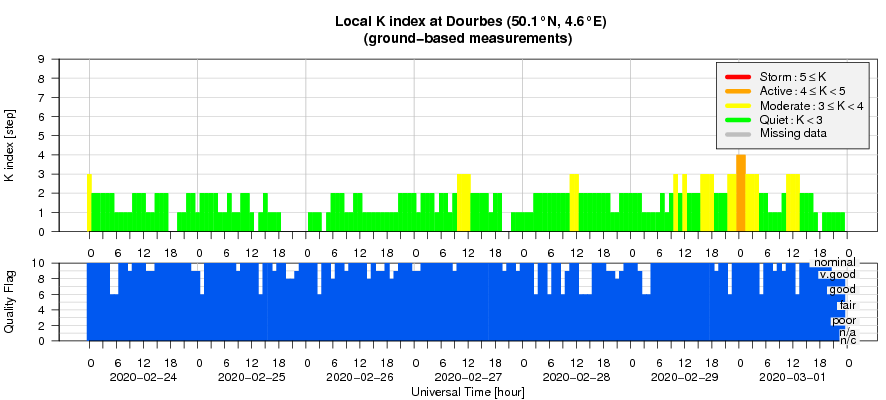- Table of Content
- 1.The EUI Telesc...
- 2.Review of sola...
- 3.PROBA2 Observa...
- 4.The Internatio...
- 5.Review of geom...
- 6.Geomagnetic Ob...
- 7.The SIDC space...
- 8.Review of iono...
2. Review of solar activity
3. PROBA2 Observations (24 Feb 2020 - 1 Mar 2020)
4. The International Sunspot Number by SILSO
5. Review of geomagnetic activity
6. Geomagnetic Observations at Dourbes (24 Feb 2020 - 1 Mar 2020)
7. The SIDC space weather Briefing
8. Review of ionospheric activity (24 Feb 2020 - 1 Mar 2020)
The EUI Telescope is Waking up (24 Feb 2020 - 1 Mar 2020)
We can confirm: EUI is in good health
The Solar Orbiter spacecraft was launched on February 10, 2020 from Cape Canaveral, US, carrying onboard the space telescope Extreme Ultraviolet Imager (EUI). On February 25, EUI received its wake up call. At this stage we can happily report that EUI is awake: its temperature is ok, its computer has been successfully powered on, completed pre-programmed self-tests and could move its filter wheel mechanisms. All good!
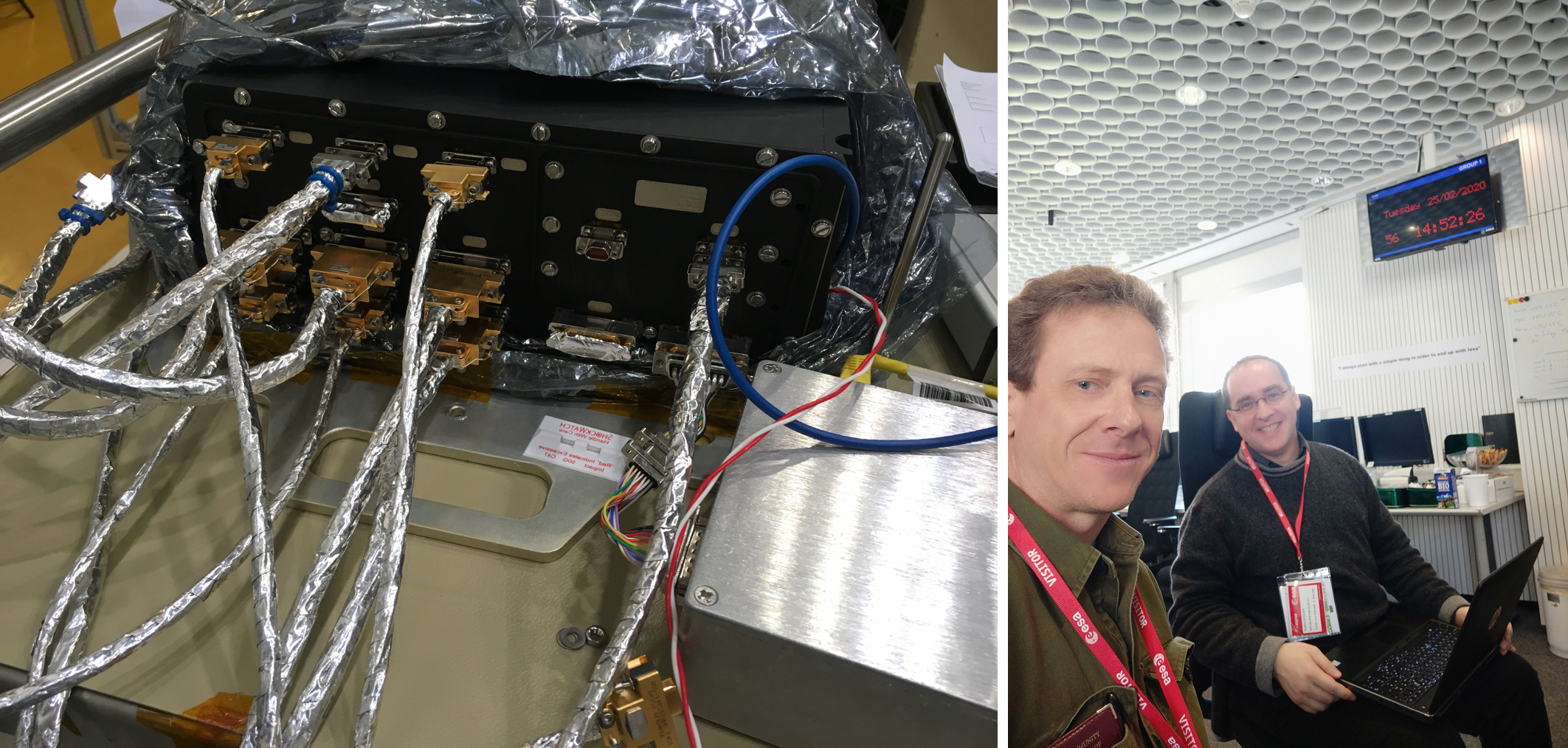
Left: the EUI computer tested on Earth - Right: Koen and Phil, the heroes of the day
Delicate business
Launching a space telescope and operating it for the first time in space is a delicate business. During the launch, the satellite and its instruments undergo a tremendous amount of vibrations. Once in space, the temperatures of the instruments can change drastically depending on the orientation of the spacecraft. Water and atmospheric particles can condense and stay glued on the sensitive areas of the instruments, creating a ‘misty window’ effect. Also, instrument electronics can be affected by extreme temperatures or space radiation. All these potential showstoppers are examined, checked and sorted out during the ‘Near-Earth Commissioning Phase’ that runs from shortly after launch till June 25. This is the day of the ‘Commissioning Review’: where all the collected information is evaluated and, if positive, Solar Orbiter is declared ready for operations.
Slowly awaken EUI
We run through a series of steps to slowly awaken EUI and finally, to get it fully up and running. On February 25, the wake-up process was initiated. A big first hurdle was taken when the “Common Electronics Box” (CEB) - this is the instrument computer - was switched on. The CEB reported to Earth that EUI was in a safe situation. This was a big relief as a failed switch-on of the CEB computer was the number 1 catastrophic risk for the EUI project and would have resulted in a dead instrument. Secondly, the computer reported that its self-tests were completed successfully, re-assuring the team that the electronics, memory and software were undamaged and ready for their duties. Thirdly, EUI confirmed that it can turn its camera filter mechanisms. In a later stage, we will ask EUI to check the camera electronics by taking an image, even if the telescope doors are still closed. Later, once the spacecraft has outgassed sufficiently and the mist has disappeared, we will ask EUI to open the telescope doors and start taking up their scientific work. The first EUI images will be released in July, together with the first images and data of the other Solar Orbiter instruments.
People behind it
Below, a short representation of the communication exchange during the 'wake-up call' of EUI from the European Space Operations Centre, ESOC, in Darmstadt. Two EUI team members from the Royal Observatory of Belgium (ROB) followed the awakening of EUI at ESOC and were available to intervene when necessary.
The other EUI team members followed from their home institutes: the Institut d'Astrophysique Spatiale (France), Max-Planck-Institut für Sonnensystemforschung (Germany), UCL-Mullard Space Science Laboratory (United Kingdom), Physikalisch-Meteorologisches Observatorium Davos/World Radiation Center (Switzerland), Centre Spatiale de Liège and the Royal Observatory of Belgium (Belgium). ROB is responsible for the scientific exploitation of EUI.
Feb 25, 16:04 CET - Philip Smith, from Darmstadt, Germany: ’Making the spacecraft Solar Orbiter ready for start up of EUI.’
Feb 25, 18:10 CET - Koen Stegen, from Darmstadt, Germany: ‘All four parts could be correctly powered on! Running self tests now. The spacecraft is 24 light-seconds away.’
Feb 25, 20:09 CET - Koen Stegen, from Darmstadt, Germany: ‘Self-tests ran fine.’
Feb 25, 21:07 CET - Koen Stegen, from Darmstadt, Germany: ‘Too soon yet to say hurray. One filter wheel moves as expected. The other filter wheel has a schönheitsfehler. This can be fixed.’
Feb 25, 20:14 CET - David Berghmans, from the Royal Observatory of Belgium: ‘The temperature of both filter wheel motors seems to be high. The heartbeat of EUI dropped.’
Feb 25, 21:17 CET - Koen Stegen, from Darmstadt, Germany: ‘We will take action. Missing heartbeats during booting of the EUI computer are normal. We will continue monitoring the heartbeat of EUI.’
Feb 25, 21:58 CET - Koen Stegen, from Darmstadt, Germany: ‘We've turned on the heaters. But they seem to heat too much.’
Feb 26, 00:32 CET - Koen Stegen, from Darmstadt, Germany: ‘We have turned on the heaters at 50% power, it will keep the temp below the critical point. I'm going home soon.’
Feb 26, 07:31 CET - David Berghmans, from the Royal Observatory of Belgium: ‘Things are looking great this morning!’
Congratulations came in from Belgium, France, Germany, Switzerland, United Kingdom.
Review of solar activity
Solar activity was very low. The Sun was spotless all week. STEREO-A/COR2 coronagraphic imagery showed a coronal mass ejection (CME) departing from the Sun's west limb on 28 February (+/- 08UT). This slow CME may have an earth-bound direction, but no related solar disk features or SOHO/LASCO CMEs have been observed to confirm this. If arriving at Earth (around 04 March), at most active geomagnetic conditions are expected. No other earth-directed coronal mass ejections (CMEs) have been observed in the available coronagraphic imagery. The greater than 10 MeV proton flux was at nominal values. The 10.7cm solar radio flux varied between 69 and 71 sfu.
Some patchy coronal holes (CHs) were visible throughout the week, with a more prominent irregularly shaped negative polarity CH transiting the central meridian on 25-27 February.
PROBA2 Observations (24 Feb 2020 - 1 Mar 2020)
Solar Activity
Solar flare activity was very low during the week.
In order to view the activity of this week in more detail, we suggest to go to the following website from which all the daily (normal and difference) movies can be accessed: https://proba2.oma.be/ssa
This page also lists the recorded flaring events.
A weekly overview movie can be found here (SWAP week 518): https://proba2.sidc.be/swap/data/mpg/movies/weekly_movies/weekly_movie_2020_02_24.mp4
Details about some of this week's events can be found further below.
If any of the linked movies are unavailable they can be found in the P2SC movie repository here: https://proba2.oma.be/swap/data/mpg/movies/
Saturday Feb 29
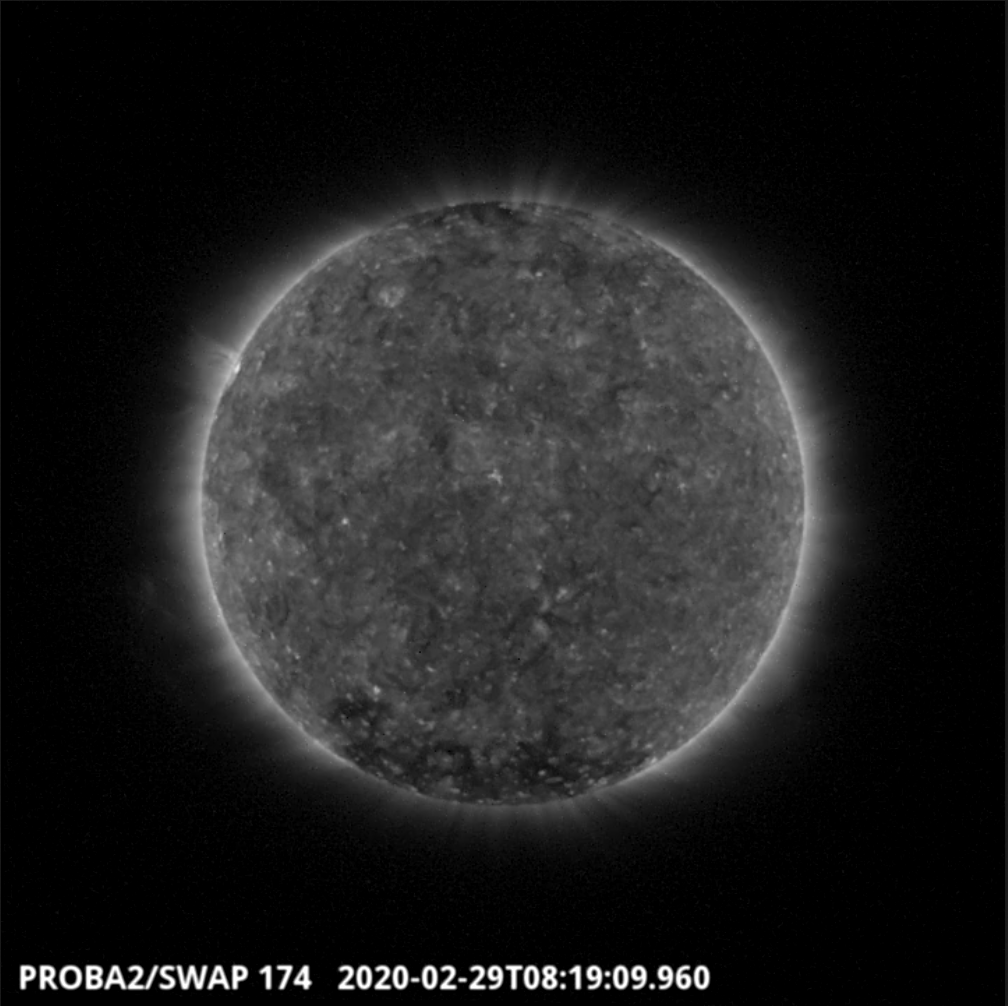
An eruption was observed by SWAP on the south-east limb on 2020-Feb-29 as shown in the SWAP image above taken at 08:19 UT.
Find a movie of the event here (SWAP movie): https://proba2.sidc.be/swap/movies/20200229_swap_movie.mp4
The International Sunspot Number by SILSO
A blank sun for the last 31 days.
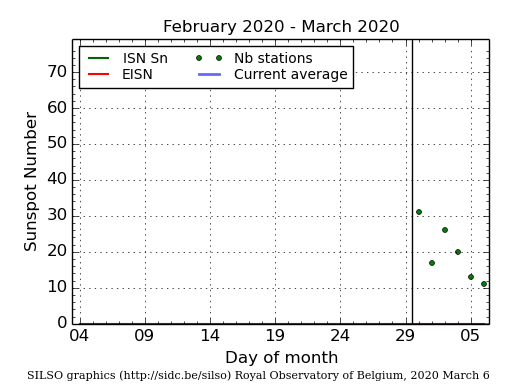
The daily Estimated International Sunspot Number (EISN, red curve with shaded error) derived by a simplified method from real-time data from the worldwide SILSO network. It extends the official Sunspot Number from the full processing of the preceding month (green line). The plot shows the last 30 days (about one solar rotation). The horizontal blue line shows the current monthly average, while the green dots give the number of stations included in the calculation of the EISN for each day.
Review of geomagnetic activity
Solar wind speed was steady between mostly 350 and 400 km/s until 28 February when a more pronounced solar wind stream from a negative polarity CH affected the earth environment. Solar wind speed reached 580 km/s late on 29 February, and Bz oscillated between -7 and +7 nT on 28-29 February.
Geomagnetic activity was mostly quiet to unsettled, reaching active levels late on 29 February (Kp, K Dourbes) and early on 1 March (Kp).
The SIDC space weather Briefing
The Space Weather Briefing presented by the forecaster on duty from February 23 to March 1. It reflects in images and graphs what is written in the Solar and Geomagnetic Activity report.

The pdf-version: http://www.stce.be/briefings/20200224_SWbriefing.pdf
The automatically running presentation: http://www.stce.be/briefings/20200302_SWbriefing.ppsm
Review of ionospheric activity (24 Feb 2020 - 1 Mar 2020)
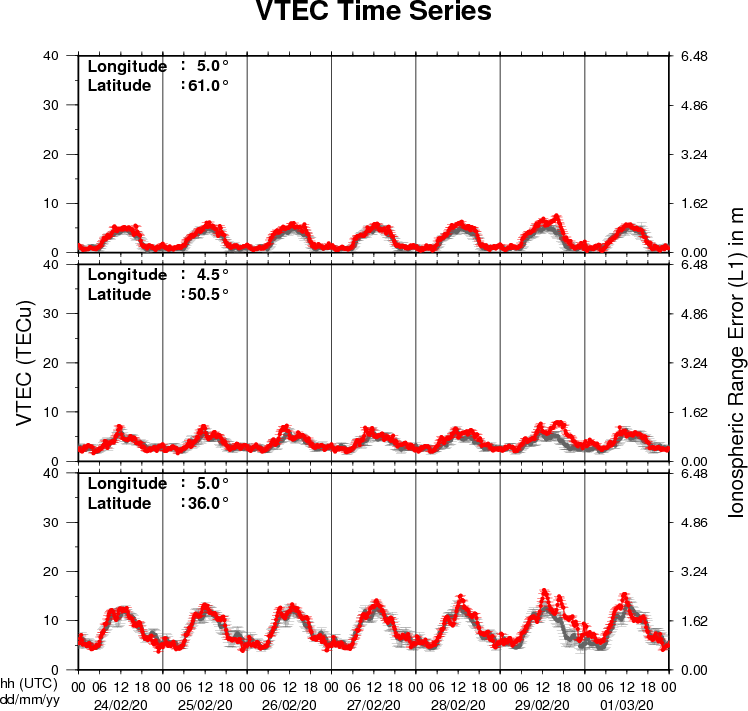
The figure shows the time evolution of the Vertical Total Electron Content (VTEC) (in red) during the last week at three locations:
a) in the northern part of Europe(N61°, 5°E)
b) above Brussels(N50.5°, 4.5°E)
c) in the southern part of Europe(N36°, 5°E)
This figure also shows (in grey) the normal ionospheric behaviour expected based on the median VTEC from the 15 previous days.
The VTEC is expressed in TECu (with TECu=10^16 electrons per square meter) and is directly related to the signal propagation delay due to the ionosphere (in figure: delay on GPS L1 frequency).
The Sun's radiation ionizes the Earth's upper atmosphere, the ionosphere, located from about 60km to 1000km above the Earth's surface.The ionization process in the ionosphere produces ions and free electrons. These electrons perturb the propagation of the GNSS (Global Navigation Satellite System) signals by inducing a so-called ionospheric delay.
See http://stce.be/newsletter/GNSS_final.pdf for some more explanations ; for detailed information, see http://gnss.be/ionosphere_tutorial.php
